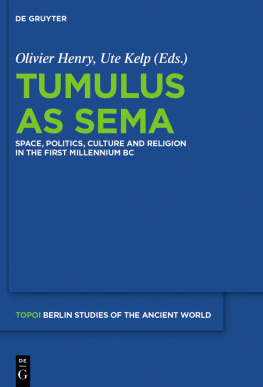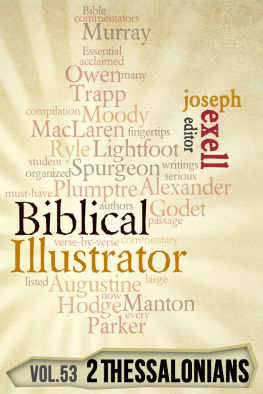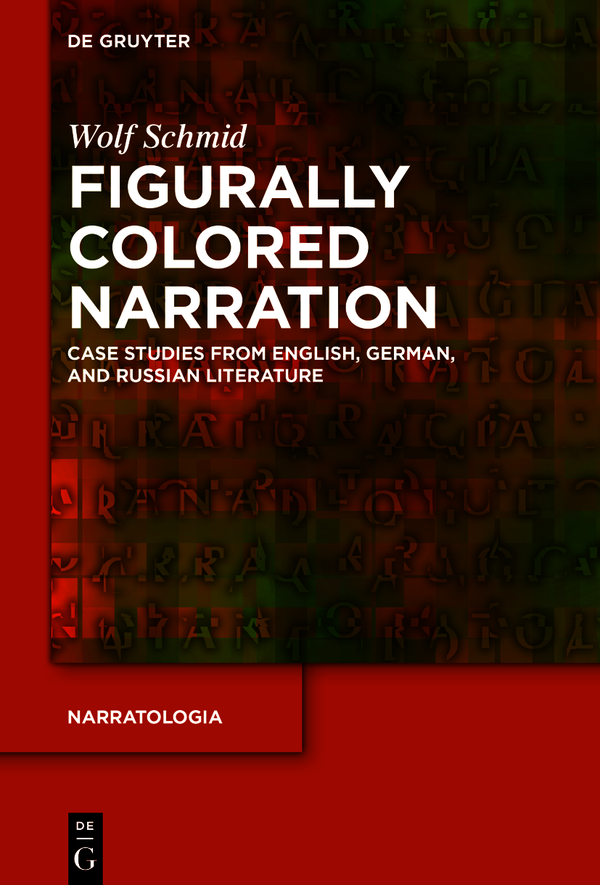Narratologia
Contributions to Narrative Theory
Edited by
Fotis Jannidis
Matas Martnez
John Pier
Wolf Schmid
Volume
ISBN 9783110763058
e-ISBN (PDF) 9783110763102
e-ISBN (EPUB) 9783110763164
Bibliographic information published by the Deutsche Nationalbibliothek
The Deutsche Nationalbibliothek lists this publication in the Deutsche Nationalbibliografie; detailed bibliographic data are available on the Internet at http://dnb.dnb.de.
2022 Walter de Gruyter GmbH, Berlin/Boston
Wolf Schmid
Figurally Colored Narration
Narratologia
Contributions to Narrative Theory
Edited by Fotis Jannidis, Matas Martnez, John Pier, Wolf Schmid (executive editor)
Editorial Board Catherine Emmott, Monika Fludernik, Jos ngel Garca Landa, Inke Gunia, Peter Hhn, Manfred Jahn, Markus Kuhn, Uri Margolin, Jan Christoph Meister, Ansgar Nnning, Marie-Laure Ryan, Jean-Marie Schaeffer, Michael Scheffel, Sabine Schlickers
Volume 81
Wolf Schmid
Figurally Colored Narration
Case Studies from English, German, and Russian Literature
ISBN 978-3-11-076305-8
e-ISBN (PDF) 978-3-11-076310-2
e-ISBN (EPUB) 978-3-11-076316-4
ISSN 1612-8427
Library of Congress Control Number: 2021952272
Bibliographic information published by the Deutsche Nationalbibliothek
The Deutsche Nationalbibliothek lists this publication in the Deutsche Nationalbibliografie;
detailed bibliographic data are available on the Internet at http://dnb.dnb.de.
2022 Walter de Gruyter GmbH, Berlin/Boston
Printing and binding: CPI books GmbH, Leck
www.degruyter.com
In memory of Johannes Holthusen, my academic teacher
Preface
The present book deals with a hitherto neglected device in narrative texts: the intrusion of figural evaluations and designations into the narrators discourse. Figural means: belonging to the discourse of a character.
The book studies figurally colored narration (FCN) using three literatures: anglophone, German, and Russian. I searched for FCN in short narrative genres in particular, since the device is by nature more often represented there.
Figural coloring of the narration is most easily recognized in works narrated by a non-diegetic narrator, i.e., a third-person narrator who does not participate in the story being told, the diegesis. This is because FCN presupposes a clear axiological and linguistic difference between narrator and character, which is only present (in the guise of the difference between narrating and narrated self) in a few diegetically narrated works.
Notwithstanding the necessary prioritization of short narrative forms and non-diegetic narrators, I have also included individual novels that exhibit the phenomenon, and in one case a novel with a diegetic narrator, Dostoevskijs The Adolescent, is examined in detail.
The texts have not been selected from the point of view of literary history, but exclusively in terms of the presence of FCN. The examination of the texts likewise does not pursue questions of literary history, but is carried out exclusively from a typological point of view. Interpretations of the texts under consideration should not, therefore, be anticipated. The examples concern manifestations of FCN and their possible functions.
The level of detail in which the texts are addressed is somewhat varied. This follows from their differing relevance to the phenomenon under investigation.
Dostoevskij plays a special role among the authors discussed. This is due to the fact that the tension between narrator and character in this authors works, both non-diegetically and diegetically narrated, manifests itself in a typically Dostoevskijan multi-voicedness. Dostoevskij was an author who was particularly aware of the problem of representing consciousness, as occasional remarks by his narrators attest. In no other author can one find so many and such varied manifestations of FCN as in Dostoevskij.
*
The English versions of the quotations are drawn from recognized published translations where available. If a published translation is not sufficiently adequate, or is unsuitable for demonstrating the point at stake, I have revised the translation. Such cases are marked tr. rev. In some cases, it was not possible to find an appropriate or indeed any published translation. It is important in our context that perspectival nuances are reflected in translation. Not a few translations are at fault for correcting the original after finding it to be stylistically deficient. The search for a suitable translation is particularly delicate with English as the target language, since in comparison with German there are relatively few translations of Russian works into English. Some authors are almost exclusively read in one canonical translation, e.g., Thomas Mann in Lowe-Porters version. Translations of primary texts that are my own, rather than drawn from published sources, are marked by asterisks.
For the sake of uniformity and bibliographical research, the Russian personal names and work titles are rendered in the international transliteration system, i.e., not Chekhov, but exov. The translated quotations also use (or have been silently modified to use) this system.
*
I sincerely thank my Hamburg colleague in English Literature, Prof. Peter Hhn, who critically read the entire manuscript and provided numerous suggestions for revision.
Since I am not a native speaker of English, I had to rely on a knowledgeable and critical proofreader. Such a corrector appeared in the shape of Dr. Alastair Matthews, to whom I extend my sincere thanks.
My thanks also go to the two anonymous reviewers who gave me valuable advice on corrections.
Introduction: Narrator and Figure
1.1 Figurally Colored Narration: Initial Definition
The present book deals with figurally colored narration (FCN),
The procedure under consideration is to be found in segments of the narration that meet the following conditions:
The narrative text is figuralized to varying degrees of density and clarity, i.e., it takes up particular features and fragments of a characters text (mainly evaluations and designations).
The figural element is not explicitly marked, i.e., there are no quotation marks, verba dicendi, putandi, or their equivalents.
In contrast to FID, figurally colored narration does not give the impression of an immediate representation of the characters current acts of consciousness.
In view of the latter stipulation, one cannot simply call FCN a device of mind representation. The consciousness of the character is represented only insofar as it is contained in the figural features and fragments brought into the narrative discourse. And these features and fragments do not refer to the current consciousness activity of the character, but rather to his or her general mindset, to constant, typical attitudes.
1.2 An Example: Anton exov, Rothschilds Violin
Let us begin by looking at an example of the device. It is taken from Anton exovs tale Rothschilds Violin (Skripka Rotilda, 1894) and forms its opening. The use of figurally colored narration is a technique typical of this authors late novellas. The narrative text of the tale begins with the following words:
, , , , . - . , . (exov, PSS, VIII, 297; italics mine W. Sch.)
The town was small, more wretched still than a village, and it was filled almost entirely with old folk, who








